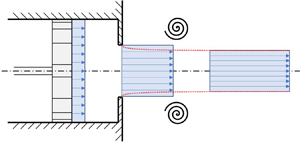Article contents
An extension to the universal time scale for vortex ring formation
Published online by Cambridge University Press: 12 March 2021
Abstract

The formation of vortex rings emanating from orifices with different orifice-to-tube diameter ratios  $D_0/D_p$ is studied using time-resolved particle image velocimetry. The invariants of the motion in their non-dimensional form are computed and presented in the non-dimensional time space
$D_0/D_p$ is studied using time-resolved particle image velocimetry. The invariants of the motion in their non-dimensional form are computed and presented in the non-dimensional time space  $t^*=U_0 t/D_0$, where the subscript 0 refers to the exhaust quantities. The classic slug-flow model is revisited and extended to account for the contraction of the flow when fluid is being pushed out through the orifice. Accordingly, a new time scale in terms of the contracted quantities (subscript
$t^*=U_0 t/D_0$, where the subscript 0 refers to the exhaust quantities. The classic slug-flow model is revisited and extended to account for the contraction of the flow when fluid is being pushed out through the orifice. Accordingly, a new time scale in terms of the contracted quantities (subscript  $\star$) is defined as
$\star$) is defined as  $T^*=U_\star t/D_\star$. Results show that the modified slug-flow model unifies the formation number of orifices and straight nozzles with a value of approximately 4.
$T^*=U_\star t/D_\star$. Results show that the modified slug-flow model unifies the formation number of orifices and straight nozzles with a value of approximately 4.
JFM classification
- Type
- JFM Papers
- Information
- Copyright
- © The Author(s), 2021. Published by Cambridge University Press
References
REFERENCES
- 10
- Cited by





